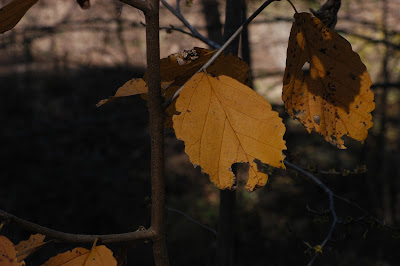Hamamelidaceae - Witch-Hazel Family
"A Year With the Trees" - Tree Number 46
Witch-Hazel
Hamamelis virginiana
Spring
The Witch-Hazel tree is identified in the spring by the leaves. These leaves are wavy toothed with uneven bases. The leaves are a dull dark green above and paler beneath. The leaves are 3-5 inches long and 2-3 inches wide. This tree is a small tree, 20-30 feet high and a diameter of 4-8 inches. The twigs are slender and zig zag.
The twigs of the Witch-Hazel tree have been used as divining rods since the 1400's. These divining rods were used to locate water, metals, gemstones and grave sites.
Summer
This photo was taken near Mount Pisgah on the Blue Ridge Parkway yesterday. What an interesting tree this is. This time of year some Witch-Hazel leaves have little hats on them. They actually look like little Halloween witch hats.
Fall
The Witch-Hazel has interesting yellow flowers that are quite stringy which appear from October to January, quite different from other trees. A good id tip for the month of Feb. is that the brown bark is often spotted. The leaves which are wavy and approximately 5 inches long, turn yellow in the fall. They will more than likely remain attached to the tree during the entire winter.
The leaves, twigs, and bark can be made into an extract that used as a topical astringent and to treat bruising on the skin. Many products are made today from the witch hazel tree for the skin and various ailments.
Winter
This Witch-Hazel lives at the North Carolina Arboretum in Asheville. http://www.ncarboretum.org/
This is the season the Witch-Hazel is filled with yellow flowers. I find it so amazing that the flowers are blooming in the winter when the rest of the forest is just starting to bud.
The Witch-Hazel tree provides much needed food for migrating birds and insects in the late fall and winter since this tree flowers very late in the year.
For the love of the trees,
Becky
"A Year With the Trees" - Tree Number 46
Witch-Hazel
Hamamelis virginiana
Spring
The Witch-Hazel tree is identified in the spring by the leaves. These leaves are wavy toothed with uneven bases. The leaves are a dull dark green above and paler beneath. The leaves are 3-5 inches long and 2-3 inches wide. This tree is a small tree, 20-30 feet high and a diameter of 4-8 inches. The twigs are slender and zig zag.
The twigs of the Witch-Hazel tree have been used as divining rods since the 1400's. These divining rods were used to locate water, metals, gemstones and grave sites.
 |
| The Witch Hazel Tree |
Summer
 |
| The Witch-Hazel leaf in the summer. The uneven base and wavy edges are two ways to identify this leaf. |
 |
| The Witch-Hazel Tree |
 |
| The Witch-Hazel Tree |
Fall
 |
| The Witch-Hazel Tree |
 |
| The Witch-Hazel Tree |
This tree has seed pods that naturally explode and fling their seeds 20 feet away. Lots of tricksters have been known to scare people with exploding witch hazel seed pods.
The Witch-Hazel has interesting yellow flowers that are quite stringy which appear from October to January, quite different from other trees. A good id tip for the month of Feb. is that the brown bark is often spotted. The leaves which are wavy and approximately 5 inches long, turn yellow in the fall. They will more than likely remain attached to the tree during the entire winter.
The leaves, twigs, and bark can be made into an extract that used as a topical astringent and to treat bruising on the skin. Many products are made today from the witch hazel tree for the skin and various ailments.
Winter
 |
| The Witch-Hazel Tre |
This is the season the Witch-Hazel is filled with yellow flowers. I find it so amazing that the flowers are blooming in the winter when the rest of the forest is just starting to bud.
The Witch-Hazel tree provides much needed food for migrating birds and insects in the late fall and winter since this tree flowers very late in the year.
 |
| The Witch-Hazel Tree - Hamamelis virginiana |
For the love of the trees,
Becky
 |
| From my journal... |




No comments:
Post a Comment